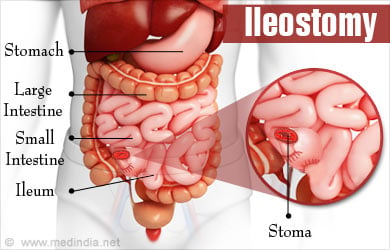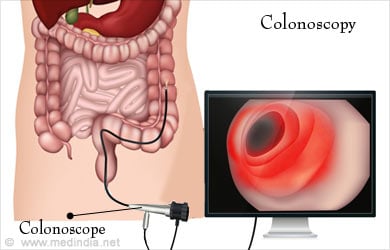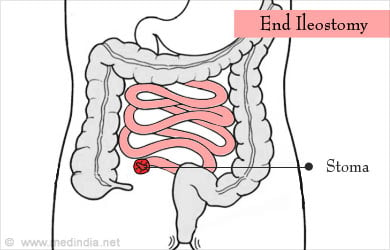What is Ileostomy?
Ileostomy is a surgical procedure where the lower end of the small intestine is diverted to an artificial opening in the abdominal wall so that it can expel out its contents to the exterior.
Ileostomy is a surgical procedure where the lower end of the small intestine is diverted to an artificial opening in the abdominal wall so that it can expel out its contents to the exterior.
The digestive waste is collected in an ileostomy bag or pouch which is attached to the abdomen and this can be discarded once it fills up.
Anatomy of Small Intestine – The small intestine or small bowel connects the lower end of the stomach to the large intestine. It consists of three parts, the C-shaped duodenum, jejunum and ileum. (Please note, ileum of the intestine is different from the ilium, which is a large bone of the pelvis). The ileum opens up into a dilated part called the caecum, which connects it to the large intestine. The small intestine is a tubular structure and about 21 feet long.
Process of Digestion - In a normal person, partly digested food from the stomach passes into the small intestines. Here, the food is broken down into a liquid consistency and the nutrients from it are absorbed. The jejunum is responsible for breaking down of the food and the ileum for absorption of the nutrients.
The contents then pass into the large intestine, where absorption of water from the digested contents takes place.
The unwanted material forms feces, which passes out of the body through the rectum and anus. If the colon is removed, you can get dehydrated if you don’t drink enough fluids.
Ileostomy is required under the following possible circumstances:
Conditions in which an ileostomy is done include the following:
Cancer - Cancer of the colon, rectum or anus. In the advanced stages may require the removal of the affected parts, necessitating an ileostomy.
Diseases of the colon - Certain diseases of the colon like ulcerative colitis or Crohn’s disease may not respond to medicines and require surgical intervention.
Familial adenomatous polyposis (FAP) - FAP is an inherited disorder characterized by cancer of the colon and rectum.
Injury to the colon - Injuries like a stab or gunshot injury or due to surgery (e.g. laparoscopic surgery) may require an ileostomy– The intervention maybe temporary or permanent depending on the extent of the injury.
Congenital Anomalies affecting the colon - Anomalies that are present from birth like the Hirschsprung (HERSH-sproong) disease or anorectal malformations
Obstruction of colon - Temporary ileostomy is performed when there is an obstruction of the colon, to allow for the passage of waste till the obstruction is removed.
Ileostomy may be Permanent or Temporary.
In permanent ileostomy, the ileostomy remains for the life time of the patient.
In temporary ileostomy, after the condition that required the ileostomy has subsided or is treated, the cut ends of the bowel are reconnected and sutured back and the ileostomy is surgically closed.
Temporary ileostomy is also used when an ileoanal pouch is created. In some cases where the colon is removed but the anus is disease free, a pouch is created from ileal tissue and is attached to the anus. While the pouch heals, a temporary ileostomy may be created from the end attached to the upper digestive tract. Once the healing is complete, the ileum is attached to the pouch and the ileostomy is closed. This internal pouch stores the feces temporarily, which the person passes out through the anus during a bowel movement. The bowel movements, however, are likely to be much more often than in a normal patient.
In an acute surgical emergency, the decision for ileostomy may need to be taken during the surgery. This type of ileostomy is usually temporary and no specific tests are done.
For all patients who undergo an elective surgery (which is a planned surgery), routine tests are required and include the following:
The need for ileostomy in such situation is established using the following tests:
Colonoscopy - In colonoscopy test, a flexible tube with a video camera and a light source is introduced through the anus into the colon to detect any pathology in the colon. Adequate preparation of the bowel is necessary prior to the procedure so that it is clear of feces.
Lower GI X-ray or CT Series - where barium is introduced through the anus, and its passage in the lower digestive tract is studied.
Type of Anesthesia - The ileostomy procedure is done under general anesthesia. You will be asleep during the procedure and not aware of what is going on.
Pre-operative Check-up - If it is an elective surgery, routine tests as indicated above are ordered a few days before the surgery. Hospitalization is required a day or two before the surgery.
Day before Surgery - An enema is administered the previous afternoon or evening before the surgery along with gut sensitive antibiotics.
The site at which the ileostomy is to be performed is marked in the sitting as well as in the standing positions by an expert or the colostomy care team.
A nurse may sit with you to explain to you about how it works. It is best to ask your surgeon if you can see the nurse or make an appointment with an expert who can explain everything about post operative care and what it involves to live with it.
Fasting before surgery - Overnight fasting is required and occasionally intravenous fluid maybe required to keep you well hydrated. Sedation is sometimes required for good overnight sleep before the surgery.
Shift from the ward or room to the waiting area in the operating room. An hour or two before the surgery you will be shifted to the operating room waiting area on a trolley. An intravenous line for fluids maybe started to keep you well hydrated.
Once the surgical room is ready, you will be shifted to the operating room.
Shift to the Operating room - The ambience in the operating room can sometimes be very daunting and a small amount of sedation can help overcome your anxiety.
From the trolley, you will be shifted on to the operating table. As you look up, you will see the operating light console and at the head end will be the anesthesia machine with monitors. There may also be monitors to check oxygen levels, ECG and other vital parameters. A constant beeping sound may be present from the monitors, which may sometimes become annoying.
Anesthesia before surgery - The anesthetist will inject drugs through an intravenous line and make you inhale some gases through a mask that will put you in deep sleep for anesthesia. Once you are in deep sleep, a tube will be inserted into your mouth and windpipe to administer the anesthesia gases to overcome pain and keep you comfortable.
Ileostomy Surgery - The abdomen is opened through a planned incision depending on the type of surgery. It can be in midline or next to it either on the right or left side. Currently more and more surgeons perform laparoscopic or robotic surgery which only require 4 to 5 small keyholes (size of a small coin) for the operation.
Once the main surgery is over, a 2.5 to 3 cms circular incision is made on the skin where the ileostomy site has been marked. The muscle below the skin is dissected and the intestine is mobilized and brought out through the opening. Types of ileostomy include the following:
End ileostomy - End ileostomy is done when the ileostomy needs to be there permanently. In this type of ileostomy, the ileum is cut through its full thickness at the desired site and the healthy end is brought out to the anterior abdominal wall.
Loop ileostomy - Loop ileostomy is done when the ileostomy needs to be temporary for a few months. In this procedure, a small cut is made in the ileum and the edges of the cut are sewed to the rim of the skin incision. A pencil-like plastic or glass rod may be kept just below the loop. This prevents the intestinal contents spilling over back into the downstream of the ileum and helps healing of a pathology like a fistula or a perforation lower down in the intestine by giving it rest. The ileostomy is closed after this healing is complete so that the patient can become normal again. Loop ileostomy is sometimes done before creating an ileoanal pouch.
Continent ileostomy - This is a relatively rarely performed procedure. A pouch is created at the healthy end of the ileum, before it can be brought out to the exterior. The pouch has a valve so that it does not overflow. The intestinal contents accumulate in the pouch, which can be emptied with a catheter at regular intervals.
Waking up from Anesthesia – Once the surgery is over, you will wake up and the tube down the wind pipe will be removed. You will be asked to open your eyes before the tube is removed. You will be sedated and the voice of the anesthetist may sound faint. Once the tube is out, you may have cough and sometimes feel nauseous and this may lead to vomiting.
There may be a tube going into the stomach called a Ryle’s tube to keep it empty. There will also be an intravenous line for fluids. You will remain on oxygen. Once fully awake, you will be shifted on the trolley and taken to the recovery room.
Recovery room – In the recovery room, a nurse will monitor your vitals and observe you for an hour or two before shifting you to the room or a ward.
Post-operative recovery – You will remain in the hospital for a few days following the procedure. Normally, on the first day, you will not be allowed much to drink or eat. Once your bowel start recovering, you will be give fluids and a light diet. This may take one to three days.
The surgeons will inspect the ileostomy the next day to ensure it looks pink and has a good blood supply. If it is too dusky or goes purple it may need revision – but this is unusual.
Change of dressing and ileostomy bags will be done as required. Intravenous lines for fluids and drugs will continue for a few days till you start eating normally.
Chest physiotherapy maybe started after 24 hours to prevent chest infection.
DVT Prophylaxis – Early movement of your legs and some mobilization prevents DVT or deep vein thrombosis, where a clot is formed in the deep veins of the legs. The clot can travel up to the lungs and even be fatal. Other measures like small dose of heparin and special stockings may also be used.
Before you are discharged, you must be fully familiar with how to take care of the ileostomy. An ileostomy can be an overwhelming experience if no counselling is available both before and after the procedure. You will need to have a positive approach towards the ileostomy, and continue with most routine activities just as before the surgery. A special nurse will train you.
What is an Ileostomy Bag or Pouch? - Following an ileostomy procedure, the contents of the intestine are now directed out through the abdominal wall. In order to prevent the contents from continuously leaking out, the opening is sealed with a small bag called ileostomy pouch.
The ileostomy pouch consists of two parts – the barrier and the disposable plastic pouch. The barrier fits around the stoma and is attached to the pouch. In some pouches, the barrier and plastic pouch are fixed to each other and cannot be separated. It is important to note that the barrier should fit well around the stoma. This prevents the intestinal contents from coming in contact with the skin and resulting in skin sores.
Instructions given following Ileostomy:
You and/or your caregiver are taught how to care for the ileostomy. The area around the stoma has to be kept clean with warm water and make sure that it is dry before a new bag can be placed.
The pouch has to be emptied several times a day when it is around one-third full, while the barrier may be replaced every 3 to 7 days. The pouch is emptied either from below, or by removing the entire bag, depending on the type of pouch. The pouch and the barrier have to be removed gently.
If a particular type of pouch does not suit the body habitus, you can opt for a different type.
There is no specific diet that is recommended. However, over time, you will learn to avoid foods that do not suit you or cause excess gas. Since a lot of fluid is lost, you will be especially instructed regarding intake of fluid and electrolytes.
If you wish to wear tight clothes, you can wear an ostomy guard over the ileostomy to prevent direct pressure over it.
Following a good dietary plan after ileostomy will aid in:
The severity of the surgery and its implications vary from one patient to another. Moreover, certain foods may affect certain people while others may not be affected as badly. This requires careful monitoring and a refrain from eating those foods that lead to indigestion.
The following are some key pointers towards an ideal ileostomy diet:
Meal times should be regular to prevent the development of gas in the body.
Drink plenty of water to stay hydrated and to prevent the blockage of the stoma.
Some foods that are known to cause indigestion, flatulence or which could potentially block the stoma should be avoided:
Abdominal fat should be avoided as excessive fat in the region could affect the functioning of the stoma.
Using a straw to drink juice or water can increase gas formation
Lying down soon after mealtime or general lowered activity can affect digestion
For conditions where the ileostomy is not permanent, another surgical procedure is carried out to close the ileostomy. During this procedure, the part of the ileum attached to the skin is separated and is attached with sutures to the remaining part of the bowel in the body, or in some cases to the ileoanal pouch.
Possible complications of ileostomy include the following:
Complications due to anesthesia:
Complications due to the surgical procedure:






